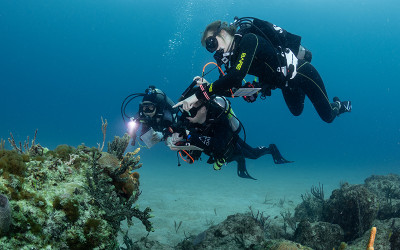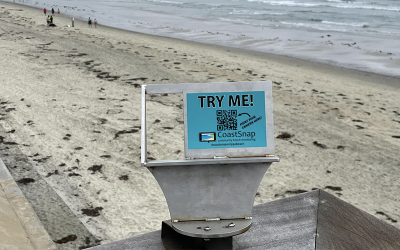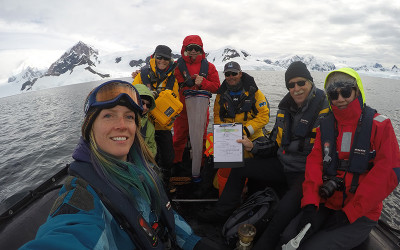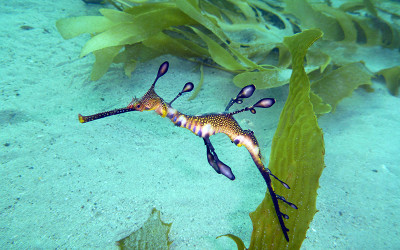New research by Scripps Institution of Oceanography at UC San Diego and Reef Environmental Education Foundation (REEF) has found that citizen science initiatives could be one of the keys to unlocking crucial insights into ecological trends.
Citizen science projects facilitate collaboration between scientific researchers and the general public with the goal of collecting data more efficiently and furthering research in ways not possible without the help of the public.
In a recent study led by Scripps Oceanography marine biologist Brice Semmens and REEF research scientist Dan Greenberg, their team evaluated the effectiveness of citizen science data compared to structured survey data in monitoring population trends of coral reef fishes in Key Largo, Fla. over the span of 25 years. Their findings were published in the journal Conservation Letters.

The team analyzed citizen science scuba diver observations made through the REEF Volunteer Fish Survey Project and a federally-funded fish population survey led by NOAA to determine the level of correlation between the two methods.
The REEF Volunteer Fish Survey Project, ongoing since 1993, allows volunteer scuba divers and snorkelers to collect and report information on marine fish populations, as well as selected invertebrate and algae species in marine waters world-wide. The data collected are housed in a publicly-accessible database on REEF’s website and allow scientists and resource managers to better understand and protect ocean ecosystems.
The study authors said the state of biodiversity worldwide has long been shrouded in mystery, primarily due to the lack of comprehensive, long-term population monitoring data. Their study presents compelling evidence that citizen science programs have the potential to address the global data crisis surrounding biodiversity monitoring.
"The large majority of species, such as groupers and snappers, were highly similar between population time series," said Semmens. "Our findings clearly indicate that citizen scientists can indeed serve as effective sentinels of ecological change."
The study also revealed variations in survey similarity across different taxonomic and trait-based groups, highlighting the need for careful consideration of methodological nuances. Despite these variances, the overall implication remains clear that citizen science has the potential to substantially augment traditional monitoring efforts, particularly for data-limited marine species, including groupers and snappers.
"This research underscores the invaluable contributions that citizen scientists can make to our understanding of biodiversity," said Christy Pattengill-Semmens, a study co-author and co-director of REEF. "By engaging thousands of scuba divers in marine life observing and reporting, we have harnessed a vast network of observers to track ecological changes and inform marine conservation."
The power of citizen science was highlighted in another recent study, led by researchers at Stanford University and Scripps Oceanography. The team uncovered a genetic link between fluorescence and color in sea anemones, thanks in part to observations collected through the community platform iNaturalist. This online social network empowers citizen scientists to document biodiversity information to help one another learn more about nature. The research team used iNaturalist to find specific locations of the sometimes rare neon-green sea anemones along the Pacific coast of North America.
“Thanks to the dedication and efforts of citizen scientists, we can gain deeper insights into the population distributions of sea anemones, the gene pool of these organisms, and much more,” said Scripps marine biologist and senior author of the study Dimitri Deheyn. “Every observation, no matter how seemingly small or insignificant, plays a crucial role in expanding our knowledge and appreciation of the natural world.”
In honor of Citizen Science Month, observed throughout April, Scripps recognizes the different ways individuals can contribute to the collective effort to advance scientific research, discoveries and local actions. Below, learn more about other research projects at Scripps Oceanography that encourage citizen science participation.
CoastSnap

CoastSnap is a global project that helps monitor changing coastlines. No matter where you are located in the world, if you have a smartphone and an interest in the coast, you are welcome to participate in this research. CoastSnap originally started in Australia in 2017, and there are now several regional projects in the United States, including San Diego. The Scripps Coastal Processes Group at the Center for Coastal Studies and then-Scripps Oceanography project scientist Julia Fielder, now a research scientist at the University of Hawaii Sea Level Center, helped launch the CoastSnap project in San Diego.
Using a technique known as photogrammetry, CoastSnap gathers data by making it easy for anyone with a smartphone to capture and submit photos of different beach locations over time. These submitted photos are valuable coastal data that is helping researchers better understand how the coast is changing due to storms, sea level rise, human activities, and other factors.
All CoastSnap station locations include a stainless steel phone cradle that overlooks a certain beach location. The general public is invited to use their phone to take a photo and share it to a centralized database via the free CoastSnap app or social media using a QR code and hashtag unique to each station. The technology behind CoastSnap can then create time-lapse videos that capture shoreline position and beach width as it evolves through time. There are currently five CoastSnap stations in San Diego, including one on the Scripps Institution of Oceanography campus on the corner of the observation deck, directly south of Scripps Pier.
FjordPhyto

Tourists visiting the polar regions in Antarctica have the opportunity to contribute to research through the FjordPhyto program, a NASA-funded citizen science project that was co-created by Scripps PhD candidate Allison Cusick and biological oceanographer Maria Vernet. FjordPhyto brings together scientists, tour operators, polar guides, and travelers to Antarctica to gather data on the community of phytoplankton species living within the fjords of Antarctica.
The Antarctic Peninsula is one of the fastest warming regions in the world. As a result, melting glaciers bring an influx of freshwater and nutrients into the fjords potentially altering phytoplankton life in the ocean.
Phytoplankton are microscopic, drifting plants that make up the base of the Antarctic food chain. They draw carbon dioxide out of the atmosphere and contribute to over half of Earth’s oxygen.
Travelers on board the tour vessels help researchers understand more about what fuels the polar ecosystem by using tools, such as nets and a CTD (a device that measures conductivity, temperature, and depth) to collect seawater measurements and samples from glacier fjords. Back on board the vessels, volunteers are able to discover the invisible forest that is phytoplankton underneath a microscope. At the end of the season, these collected samples taken by citizen scientists make their way back to the Vernet Lab at Scripps Oceanography to be analyzed by researchers.
SeadragonSearch

SeadragonSearch is a community-driven research initiative that increases understanding of wild seadragon populations. Greg Rouse is a marine biologist at Scripps Oceanography and one of the leaders of the SeadragonSearch Project who helps gather data collected from the community to plan for the conservation of seadragons. There are currently only three known species of seadragons, so they remain relatively mysterious to scientists. Seadragons live in shallow algal habitats and are particularly vulnerable to climate change.
This project uses artificial intelligence tools to identify individual seadragons from photos taken by community members and uploaded to the SeadragonSearch website. The resulting data about their lifespans and other traits will inform conservation policy for these fishes and their habitats.
Once community members submit their photographs of seadragons, researchers are able to analyze the unique patterns on each seadragon’s face or body. A machine learning algorithm suggests possible matches to other photos in the system, and researchers review those matches and assign each dragon to an individual identity. As sightings of individuals are repeated, the fish can be tracked by a variety of parameters, including year, season, and location.
About Scripps Oceanography
Scripps Institution of Oceanography at the University of California San Diego is one of the world’s most important centers for global earth science research and education. In its second century of discovery, Scripps scientists work to understand and protect the planet, and investigate our oceans, Earth, and atmosphere to find solutions to our greatest environmental challenges. Scripps offers unparalleled education and training for the next generation of scientific and environmental leaders through its undergraduate, master’s and doctoral programs. The institution also operates a fleet of four oceanographic research vessels, and is home to Birch Aquarium at Scripps, the public exploration center that welcomes 500,000 visitors each year.
About UC San Diego
At the University of California San Diego, we embrace a culture of exploration and experimentation. Established in 1960, UC San Diego has been shaped by exceptional scholars who aren’t afraid to look deeper, challenge expectations and redefine conventional wisdom. As one of the top 15 research universities in the world, we are driving innovation and change to advance society, propel economic growth and make our world a better place. Learn more at ucsd.edu.



